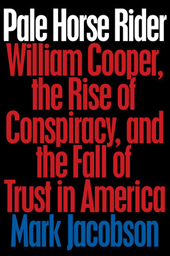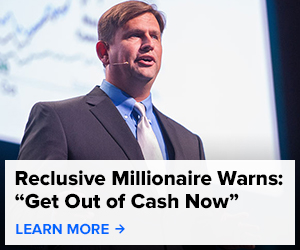
A new book about Bill Cooper, radio show host and author of Behold a Pale Horse, examines the wide appeal and demise of this popular conspiracy theorist who died in 2001.
By S.T. Patrick
Behold a Pale Horse is a miracle story in independent publishing. This haphazardly compiled book of personal tales, documents, newspaper clippings, facsimiles, reports, interviews, pamphlets, and transcripts has sold over 300,000 copies since 2005. Its organizer, Milton William (Bill) Cooper, lived no such miracle. Gunned down on his front porch on Nov. 6, 2001, his dubious rise and fall resembled a fictional suspense story more than Shakespearean tragedy.

The genius, intentional or not, of Behold a Pale Horse is its senseless organization. It reads like an underground set of documents that your security clearance is not advanced enough to access. Yet, you have them in hand and the world, the real world, is now open to you—maybe for the first time. That also explains the book’s widespread popularity among prison populations.
It is a classic within prisons, and it isn’t hard to understand the reasons that make this so. Prisoners naturally feel cheated, as if they have been victims of systemic racism, for-profit internment, and laws aimed at keeping the economically disadvantaged permanently downtrodden. Cooper named the cheaters, however, which accounts for its appeal.
Author Mark Jacobson’s newest book, Pale Horse Rider: William Cooper, the Rise of Conspiracy, and the Fall of Trust in America, is an energetic, wonderfully written, even-handed look at the life, mind, and work of Cooper. Jacobson is a keen cultural observer and chronicler of urban life. His journalism was the basis for the film “American Gangster” and the television series “Taxi.” He looks at Cooper not as another boastful conspiracist, which he was, but as something more complex and more unique. Cooper offered something street-corner peddlers and billion-dollar news organizations did not.
“In contrast to the orthodoxies of so-called ‘Truth’ movements, as well the divide-and-conquer techniques of the mass media propaganda cults like MSNBC and Fox News, Cooper offered an individualized, auto-didactic path to knowledge,” Jacobson wrote in an essay for Publishers Weekly. “It was in the ‘standard admonition,’ his challenge (which all fans know by heart) ‘to read everything, listen to everyone, but believe nothing until you can prove it with your own research.’ ”
Cooper believed many things, and he would regale audiences with his stories, lectures, and explanations on the shortwave radio program “The Hour of the Time,” which he hosted from 1993 until 2001. While he could be appreciably prescient, his theories often tiptoed along the border of fringe.
He claimed that on Feb. 21, 1954, President Dwight D. Eisenhower met with the Pleiadian star system ambassador O.H. Krill to forge an alien abduction agreement that would allow human abductions by extraterrestrials in exchange for advanced weaponry that would keep the U.S. ahead of the Soviets in the growing arms race of the Cold War.
Cooper also popularized the theory that limousine driver William Greer was the true assassin of President John F. Kennedy.
One of the bombshells of Behold a Pale Horse, Cooper claims to have been on a mission that allowed him to access a top-secret vault. Within the vault, Cooper found an Office of Naval Intelligence report that stated Greer had indeed shot the president. At his public lectures, he would hawk fifth-generation copies of the Zapruder film which “proved” the theory.
Cooper’s version of the assassination convinced another Arizona-based researcher and author, Ralph Epperson, who had done a series of interviews on Cooper’s program and had written the landmark The Unseen Hand: An Introduction to the Conspiratorial View of History. The theory has since been chided and discarded by the vast majority of Kennedy assassination researchers.
Part of the appeal Cooper had with the African-American community resided with his belief that both the dissemination of drugs into the inner cities and the proliferation of the AIDS virus were intentional intelligence operations aimed at blacks, homosexuals, and Hispanics. A cure for AIDS, according to Cooper, was created before the plan to decrease minority populations was implemented. In 2000, South Africa’s minister of health distributed the corresponding chapter from Behold a Pale Horse to senior government officials and friends. This was part of Cooper’s contradiction and also a reason why he remains difficult to pigeonhole as forcing one specific ideology serving one audience of extremists.
A recent Rolling Stone magazine piece called him “the Granddaddy of American Conspiracy Theorists,” but he has also been dismissively labeled the “Titan of the Tin Foil Hats” and derided as a “militia theoretician.” That Cooper strongly appealed to those on the far right of the American political spectrum is undeniable, but what cannot be discounted or excused as frivolous is that he also inspired modern rap music by the likes of popular stars such as Tupac Shakur, Busta Rhymes, and the Wu-Tang Clan.
Cooper’s program was enlightening for those who had only read local newspapers or had watched mainstream news. For the first time, a listener could hear about the power of the Bilderberg Group, the history of the Illuminati, the establishment of the New World Order, the murder of James Forrestal, the Majestic-12 papers, or the plan to create an alien invasion hoax as a way to establish martial law and complete control over the people of the world. What the journalistic establishment still chuckles away as crazed ramblings, however, turned very real on Cooper’s June 28, 2001 episode.
 Cooper predicted that a major attack would soon befall the United States. It would be a path to bigger government, more surveillance, militarization of police, and an expansion of FEMA. These were familiar talking points for Cooper. Then came the eerie specifics. The intelligence services had been eluded by an Islamic extremist named Osama bin Laden for years, yet CNN had just interviewed him.
Cooper predicted that a major attack would soon befall the United States. It would be a path to bigger government, more surveillance, militarization of police, and an expansion of FEMA. These were familiar talking points for Cooper. Then came the eerie specifics. The intelligence services had been eluded by an Islamic extremist named Osama bin Laden for years, yet CNN had just interviewed him.
“But some doofus reporter with his little camera crew waltzes right into his secret hideout and interviews him!” Cooper exclaimed to his audience. “Something terrible is going to happen in this country. And whatever is going to happen, they’re going to blame on Osama bin Laden. Don’t you even believe it!”
Two-and-a-half months later, 9/11 forever changed American history.
Cooper soon after also prophesied his own demise. The authorities were going to make their way to his rural Arizona home “in the middle of the night and shoot me dead on my doorstep.”
At around midnight, on Nov. 6, 2001, Apache County Sheriff’s deputies attempted to arrest Cooper at his Eagar, Ariz., home. After an explosion of gunfire, Cooper was dead on his doorstep.
Revelation 6:8 is the Bible verse from which Cooper’s most famous work drew its name. It reads, “And I looked, and behold a pale horse: and the name that sat upon him was Death.” Cooper was dead at 58.
Jacobson’s Pale Horse Rider is the eulogy that Cooper deserved. Sourced from Cooper’s friends, family, adversaries, admirers, and detractors, it is the best example yet of being fair to controversy.
Last year, Cooper’s Behold a Pale Horse rose as high as number 17 on Amazon.com. States such as Florida have banned the book as an inflammatory work in their prison systems, yet its presence remains widespread.
In 1971, songwriter Kris Kristofferson released a song he had written for his most complicated friends. The chorus of “The Pilgrim, Chapter 33” can also describe a character such as Cooper: “He’s a poet, he’s a picker. He’s a prophet, he’s a pusher. He’s a pilgrim and a preacher, and a problem when he’s stoned. He’s a walkin’ contradiction, partly truth and partly fiction, takin’ ev’ry wrong direction on his lonely way back home.”
S.T. Patrick holds degrees in both journalism and social studies education. He spent 10 years as an educator and now hosts the “Midnight Writer News Show.” His email is [email protected]. He is also an occasional contributor to The Barnes Review (TBR) history magazine. For a sample copy of TBR, please call 202-547-5586.
